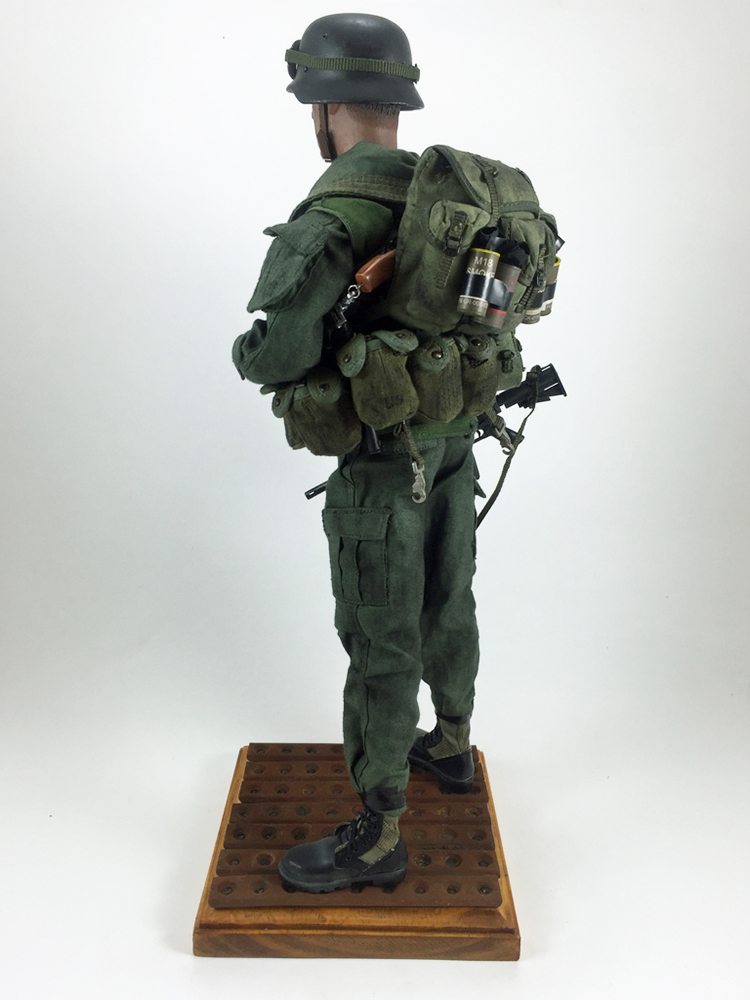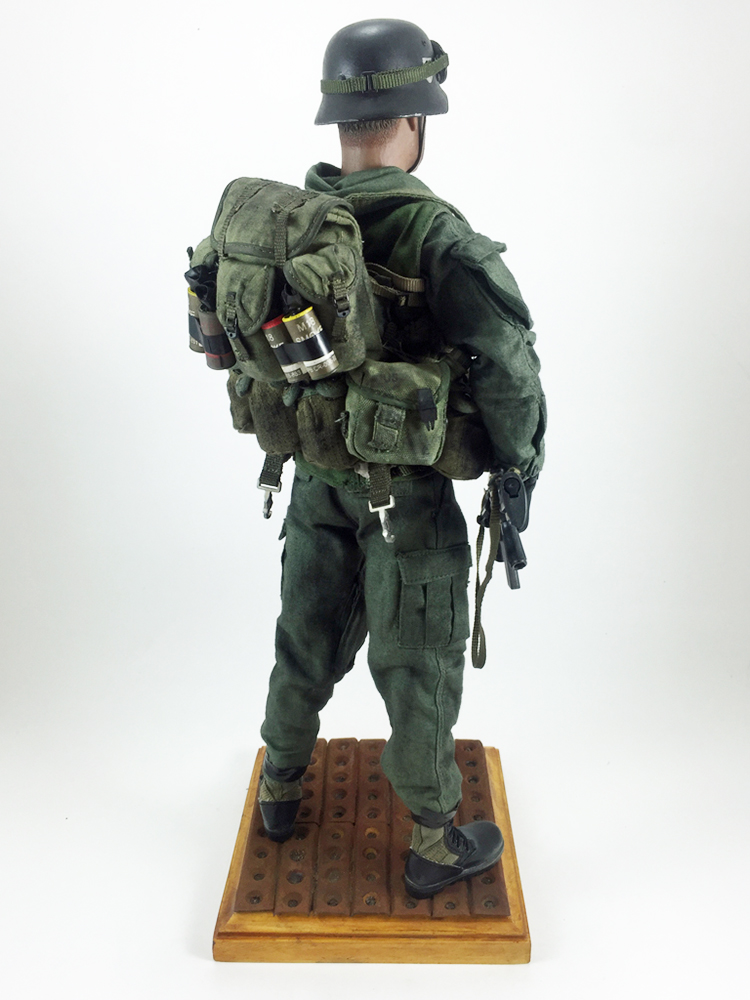Our friend Ryan Peterson has created a new custom figure of the legendary Nick Brokhausen. You can see an intervierw and pictures from Brokhausen here. The interview below was used as reference for this 1/6 figure.
CC: What kind of holster did you use to hold the M79 or shotgun and how was it secured? From the one photo I could see of the back of your webgear, I didn't see any space to attach it on the web belt.
Brokhausen: I had one of the filipino armorers, sew me a special holster that fitted the cut down M 79. It was stiff webbing so that it retained its shape. It then fitted over the cross straps of the STABO rig on the back, by three Velcroed straps. This proved to be the right position as it rested slightly above top of the canteen covers in the rear where I had my emergency equipment and one that was filled with mini grenades. I could get to the Thump or the grenade pouch easily after much practice. The biggest problem with the sawed off thump was the front hand guard is also where the spring take down is located. they solved this by welding on hooked extensions so the bloody thing wouldnt fall apart during reloading.
With the ruck on it would have pressed the THump down and rotated away so the handle would be easier to grab and pull out, same with the sawed off Greener.
CC: Then I assume that sling attached to the left side of your webgear was part of a retention system. Can you clarify how it was attached to the STABO?
Brokhausen: In the back the STABO comes to a cross at a point between the shoulder blades. The center strap for the sling holster went over this cross. The two side straps attach to the STABO just above the pistol belt. From the left side would be one canteen cover full of mini grenades, the next cover would hold one canteen of water, the next had survival gear, the next would have been a two quart canteen then on the right rear hip would be the first cover with one thirty and six twenty round mags for the CAR 15 all with bullets facing out ( i have been hit in the pouch and had all the rounds cook off, better that they fire away from you than into you. I always carried the grenades in the rear for the same reason, I didn't spend a lot of time running away , so less chance of getting hit in the back. You are right about the sling and snap, that was for the sawed off Thump when I wanted it up front. like during Bright Lights and for stabilizing the RPD Machine gun so I didn't have to bear all the weight on my arms. If I was carrying The RPD instead of the CAR 15 the canteen covers held fifty round belts. I carried an extra two hundred rounds belted up in my ruck along with two soap dish claymores, one regular claymore, one 60 mm HE for the two inch mortar, or extra bandoleers of 5.56 mm for the CAR.
CC: How did you favor carrying your pistol (Hi-Standard or PPK)? With a holster, a piece of para-cord, etc...?
Brokhausen: I always carried the pistol in a holster, separate from my STABO.
CC: Was all of your equipment spray painted, including the rucksack? I could see that most of your webgear was camouflaged that way, including the Chicom rig.
Brokhausen: WE spray painted most everything, once it washed washed or had been out in the bush it became faded to just the right shade of shadow. I never painted weapons some did. Cook used top write little messages on his grenades but I thought that was tacky.
CC: Can you describe the combat loads that you carried and how it was arranged?
Brokhausen: Normal loads
carrying the CAR 15 and thump
10 40mm HE on my 10 vest. 10 more in cover 5 on the belt,
600 rounds 5.56 in 20 round mags on the belt
360 rounds in 30 round mags one per pouch and six in an AK vest on my chest.
4 mags 9mm or 22 for the silenced pistol, Two M67 frags on the pouchs under the arm pits for the AK vest Four more in the pouchs. 10 Mini frags, One CS, two mini CS, Two smoke. Rations in the ruck usually PIRs LRRPs made for the indig, lots of fish and nuc mam, rice etc. So we smelled like asians not gringos when we sweat.
When I carried the RPD I had a 100 round drum on the gun Two suspended from the hook, plus six fifty round belts in the covers and an extra two hundred in my ruck. Everyone else carried an extra fifty round belt for me if we had to make house calls and I ran low. I also attached a metal funnel to the barrel as a flash channeler, after the Cuban showed me his. At night it would spit green balls of energy which scared the shit out of everyone but gave your position away. By sawing off the barrel you get a slight decrease in RPM but it saves a lot of weight and makes the gun easier to handle in the bush. I carried the saed off double barrel 12 gauge in the slide holster so that I could hold it in one hand while reloading the RPD, usually thirty rounds of ammo, OO buck, slug and Ones packed with 10 Dong piece coins. ( Made of brass about the size of a nickel , seven to shell, they would cut a man in half at five meters>)
This sounds like a lot, but I have run Bright Lights before and gotten back to the helicopter with only pistol ammo remaining , with my clothes on fire and a water blister the size of a football on my head from calling in Nape, danger close.
I weighed 140 lbs soak and wet at the time. add blood bags morphine and tricks and we carried a lot of weight , but when you needed it you could fight. We could take on a 200 man unit with eight guys and give them a blooding they wouldnt forget. Our normal reaction was close with them , beat them down, kill as many as you can and break through or break contact, then run for terrain where you can hold them then pray the air assets get to you before the weather socks in.
CC: Did you have any peculiar modifications for your uniform? I can see that you have additional sleeves on your pockets.
Brokhausen: Start off by getting the OD Green Jungle fatigues, wash them several times after ripping off the bottom pockets, shirts were tucked in and taped with black elec tape as were the ankles. Sew the bottom pockets on the upper arm right at the shoulder, one keeps the morphine and the other is lined with a plastic bag to hold your CAK codes and any SOI material. Use an old screen door and overspray the outfit then when that dries TWIST them and spray it again in black matte. Looks like tiger fatigues.
Sew two 4 inch by ten inch pockets ( expandable) on the inner thighs of the pants, use one for ration and the other for blood bags. Trick is not to stuff them so you walk bowlegged but just enough so you can move normal. That way you always have food and meds I always shoved bullion cubes in with the blood bag as emergency rats.
We wore boony hats, which are normal jungle hats but with a cut down skinny rim. I mostly just wore a cravat unless it was raining, then any broad leaf would do.
CC: Can you explain a little bit more about the inner thigh pockets? I haven’t actually seen those before.
Brokhausen: Usually I used it for the PIRs I could have two hot meals ( body heat) cooking while I was running for my life hyperventilating.
Blood bags are forced in the body by weight if you cant hang a drip, although towards the end the medics were saying give Serum Alb up the alimentary canal same with saline. never tried it, but became adept at finding and getting an IV started on collapsed veins.



|
